All adolescents go through several stages of bodily changes in order to become fully grown men. Bodily changes will happen in due time and at a certain speed - whether you are ready for it or not!
Definitions
Ejaculation literary significance"suddenly" and refers to the seminal fluid coming out of the egoized penis. (slang - cum, ejaculate) Semen is the liquid in which sperm lives. (slang for sperm) Orgasm Deep sensations and muscle contractions associated with ejaculation. Pubic Hair Dark curly hair that grows on your body near the penis and testicles.Other, better known definitions
puberty, maturation, Transitional age
Concerns
- Other boys develop faster than me
- Is everything that happens to me "normal"?
- Can I speed up the process?
- Why is the hair on my maturing body growing so slowly?
Data
Typical sequence of bodily changes: (1)(16)
| Age | CHARACTERISTIC |
|
|---|---|---|
| 10.0 | Male hormones are activated, but there are practically no external changes. The testicles begin to mature, and in some boys, intensive growth begins during this period. | |
| 11.5 | Enlargement of the genitals, especially the scrotum, with redness and change in skin texture. The penis is not yet growing at this stage. | |
| 12.6 | Bulges begin to appear on the chest in 30% of boys. (temporary, sometimes painful chest pain) |
|
| 12.7 | Broadening of the shoulders increase in growth. Pubic hair appears in the penis area. Lots of erections. |
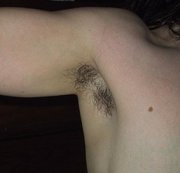 |
| 13.5 | Dark wavy pubic hair appears in the penis area. The penis increases in length, but not in width. The skin on the penis becomes darker. |
|
| 13.6 | The testicles and scrotum continue to develop. Early voice change - lowering ("voice breaks") |
|
| 13.7 | First ejaculation of seminal fluid from the penis |
|
| 14.2 | The size and length of the penis increases. The testicles and scrotum continue to grow. The pubic hair is beginning to take on its adult texture, although it does not yet cover the entire area. |
|
| 14.5 | Period of rapid growth h (growth spurt). The body/face is looking more and more like an adult. | |
| 14.9 | Underarm hair appears Sex glands and a characteristic aroma develop. Pimples appear on the face |
|
| 15.0 | Increased vegetation under the lower lip and on the chin. The voice breaks and the skin becomes more oily. The testicles and scrotum are still developing. | |
| 15.9 | Maximum growth of pubic hair. Hair growing on legs |
|
| 16.0 | Nearly full male stature and physical build. Pubic hair and genitals like an adult male. Facial hair grows faster and now or a little later, the teenager begins to shave. | |
| 19.0 | Male body structure. The testicles and scrotum are finally formed. | |
| 20.0 | Some men continue to develop, hair continues to grow, especially on the chest. | |
| 22.0 | Complete puberty |
The age indicated in the table is average and should not be emphasized too much. For example, average age ejaculation in boys according to the table is 13.7 years, but in fact these figures can vary from 9 to 18 years!
The order of events is also approximate and the sequence of events may differ for each individual. For example, you can survive ejaculation before the appearance of pubic hair, although the sequence of events in the table is reversed. Do not worry, everything will happen in due time and basically in the sequence that is given in the table.
Why more hair?
The extra hair on your body has several functions: it signals puberty - that your body is ready for sexual reproduction. It also complements the sexual sensations when having sex with a partner. Finally, the underarm and penile hairs release an oily substance that creates its own unique bodily fragrance. The same mechanism contributes to the establishment of a connection between 2 partners during sex - the partner's aroma is deposited in the brain, along with the pleasant sensation of sexual intercourse, into a strong mental association that is difficult to destroy.
Confusion
Many boys will be embarrassed that other people will begin to notice the physical changes happening to them. If someone, for example, notices and makes a remark about the hair growing under the armpits, then many guys will be embarrassed and try to hide these obvious changes happening to them.
You will quickly get used to these changes.
Delayed Growing Up
It seems that nothing can lower a teenager's self-esteem as much as slow physical development compared to their peers. Especially when teenagers take a shower together after playing sports (a feature of the American educational system). Adolescents of the same age can be very different in physical development. It is a small consolation for a late developing teenager to know that the puberty process will begin in due time. This boy mentally torments himself about his physical development.
What can be done?
Zinc is involved in hormonal activities, especially those associated with the (male) gonads. (28)
Make sure you eat a balanced diet that includes foods rich in the mineral zinc. Lack of the mineral zinc has been linked to stunted growth and sexual development in adolescents!
Foods rich in zinc: Cheese, meat, bread, fish, shells, milk, pumpkin seeds, seeds, mung beans, edible lentils.
You can also take zinc rich tablets. The recommended daily dose of zinc is 15 mg/day. Do not take more than the daily allowance, this can lead to complications. Consult a doctor! Relax - zinc is not a drug - it's a natural product.
Finally, make an appointment with your doctor and check your physical condition if you are worried about delayed puberty.
The Progress of Puberty - One Boy's Story
 (I bow and thank the boy who shared personal problems and photos with the whole world. He understands that this information can help and reassure other guys).
(I bow and thank the boy who shared personal problems and photos with the whole world. He understands that this information can help and reassure other guys).
| Age | Hair armpits |
Pubic hair (distance from penis) | Leg hair | facial hair | Voice | |
|---|---|---|---|---|---|---|
| 12 years + 10 months | No | first appearance of hair | No | No | boy's voice | |
| 14 years old | first appearance of hair | 18 mm (0.7 yd) | click on image48 mm (1.9 yd) | No | No | starts to break |
| 15 years | start to appear | light colored hair upper lip and a little on the face | constantly breaking down | |||
| 15 years + 3 months | personal embarrassment about our young guys means the end of the stage (probably you felt the same at this stage) |
|||||
There is no right or wrong when it comes to the speed, order, or degree of physical change. For some boys, leg hair will begin to grow at the same time as armpit hair. For some, hair will begin to grow faster or slower than shown in the chart. The table refers to only one particular boy. Compare your story with that of this boy.
body structure
Body structure is a huge problem for teenagers. We are often exploited by the image of a perfect body, it is difficult for boys to love their body when they look in the mirror. Basically, the structure of the body is transmitted from the parent through the genes.
It is possible to slightly change the physique. If you eat a lot of food and do not play sports, then become full. If you exercise a lot and watch your diet, then you will improve your physique. Basically, that's all you can do with your physique.
The Bible says "the beauty of young children is in their strength", meaning that the beauty is in ourselves, we must be strong. As you grow older, your muscles will form, and exercise will strengthen them even more. You can work on this area if you have the necessary motivation. Just stay away from steroids - you don't need physical strength at this price!
It is important that you continue to eat right and do not try to lose weight by copying advertising images of models. Your body during the period of growing up will change its shape without any outside help. I know a lot of overweight guys who, as they grew up, became slim, without a drop of excess weight.
The most important thing is to accept yourself the way you are. Love yourself! Some people realize this simple truth too late. You will find peace by realizing this. I knew one guy who was physically ugly and had an average build. But he was a very friendly and open person, and you quickly forgot about his physical shortcomings. He was either blind or accepted himself as he was, which was reflected in his personality. Everyone loved him - it was great to spend time with him.
If you think that by changing your physique you will be treated better, then you are mistaken! Friends and family love you just the way you are. If they loved you more if you were taller, thinner, stronger, then nothing would change for you! You would then know who your real friends are! Thinking that you would be more loved with a different body can lead to nutritional problems and psychological barriers that are then difficult to overcome.
Make the tough decision and accept yourself for who you are!
Increasing Pains
"Rising Pains" in teenagers refers to pain in the knees. Experts do not come to a consensus about the causes of the emerging pain. Some say this is because the long bones in the legs continue to grow, stretching the slowly growing muscles and putting pressure on the part of the bone where the muscles are attached. Others argue that the reason for the pain is that children are exercising beyond their physical capabilities. (22)
Experts agree that the pain is real and that rest and stretching of the muscles is recommended as a treatment. (22)
At 9-10 years old for girls and at 11-12 years old for boys, a new and responsible period of life begins - adolescence.
Adolescence. Rapid, unstoppable growth and development, improvement of physical and mental abilities, formation of will, character, worldview occur in a relatively short time (about three years) and end in youth. Adolescence and adolescence are sometimes combined by one name - puberty. It ends in boys by 18 - 19, in girls - by 16 - 17 years. By this time, the proportions of the body are fully formed, the growth and ossification of the skeleton is completed. During puberty in young men, body weight increases by an average of 34 kg, height - by 35 cm, chest circumference by 25 cm; in girls, respectively, by 25 kg, 28 cm and 18 cm. These changes are associated with the intense activity of systems and organs that regulate growth processes and ensure the normal functioning of the body. At the same time, the regulatory systems themselves (primarily the nervous and endocrine systems) continue their own development and formation.
The maturation of the body is not an easy process, it does not always go smoothly. That is why adolescents require close (but not intrusive) attention from their parents, constant monitoring, and sometimes, if not "work" separate links in a complex chain of development and formation of the body, and the direct intervention of a doctor. At the age of 10, the physical development of boys and girls is approximately the same, but at 11 years old, girls are ahead of their peers in height (by 1.6 cm) and weight (by 1.7 kg). At the age of 12, girls are ahead of boys in all respects: body length (by 3.1 cm), weight (by 2.9 kg), chest circumference and excursion (by 4.5 and 0.7 cm). At the age of 13, this difference increases even more.
However, at the age of 14, all indicators physical development become higher in boys. These differences are due to the fact that girls enter adolescence 2 years earlier than boys, they have the so-called pubertal “growth spurt” earlier, i.e. a significant acceleration of height and weight. In girls, it is observed at the age of 10.5 up to 13 years, in boys - from 12.5 to 15. Pubertal "growth spurt" precedes the onset of puberty. There is a development and increase in the activity of the endocrine glands, genital organs. Puberty occurs in girls at 12.5 - 13 years, in boys - at 14 - 15 years. At this age, girls begin menstruation, boys have wet dreams.
Adolescents complete their anatomical development nervous system. By the age of 13-14, the formation of the motor analyzer is completed, which has great value for the formation of endurance, dexterity, necessary in labor activity.
The growth of skeletal muscles caused by endocrine stimulation significantly affects muscle strength. So, if at 10 years old boys squeeze a hand dynamometer with a force of 16 kg, then at 15 years old this figure is 35 kg; in girls, the strength of the hand increases over the same period, on average, from 12.5 to 28 kg. It should be noted that in girls, muscle strength reaches its maximum development by the age of 15. Characteristic for teenagers angularity, clumsiness and awkwardness (which is explained by the faster growth of bones and muscles in length and the temporary lag in their development in thickness) disappear in boys after 15 years, in girls - a little earlier.
Teenagers have a fast growing heart. Perhaps, there are no such high requirements for any system of the body in adolescence and youth as for the cardiovascular system. The weight of the heart from 10 to 16 years doubles, and the volume increases by about 2.4 times. The heart muscle (myocardium) also changes, becomes more powerful, is able to throw more blood into the vessels during contraction. At the age of 9 to 17 years, the stroke volume of the heart, i.e. the amount of blood ejected by the heart in one contraction, increases in boys from 37 to 70 ml, and in girls from 35 to 60 ml. The resting heart rate gradually decreases. At the age of 15, the pulse in boys is 70, and in girls - 72 beats / min, by the age of 18 it decreases to 62 and 70 beats / min, respectively, that is, it becomes the same as in adults. However, the decrease in heart rate is uneven, and this is due to the rate of growth and puberty.
For example, at the same age (15 years) in rapidly developing girls, the cardiovascular system works approximately the same as in adult women, and in their peers who are lagging behind in growth and development, the nature of the work of the heart is almost the same as in younger schoolgirls. The same is observed in boys. Consequently, the first feature of the adolescent's circulatory system is its close connection with the rate of growth and maturation of the whole organism.
It should be noted that in a rapidly growing organism, the development of the cardiovascular system does not always keep pace with the general pace of development, and an increase in heart mass sometimes lags behind an increase in whole body mass. That is why sometimes tall boys and girls complain of weakness, easy fatigue, especially during physical exertion, there is a tendency to faint when overheating or a sharp change in body position. When symptoms of heart weakness appear, associated with a discrepancy between growth and an increase in the size of the heart, some parents regard them as a manifestation of heart disease, try to transfer their son or daughter to the most gentle mode, and protect them from all kinds of physical exertion. This big mistake. The only medicine that can bring into line the capabilities of the circulatory system and the increased needs of the body of a teenager are systematic physical exercises, sports, and work. Unfortunately, now the majority of modern children, adolescents, young men (and adults) have the main problem of underloading muscles, inactivity.
Often, young men and women, embarrassed by their weakness and awkwardness, completely cease to engage in physical education. As a result, the so-called drip heart is formed, which, if a teenager does not start physical education on time, will not increase in the future.
In the developing circulatory system, there is often a discrepancy between the lumen of the vessels through which blood is ejected from the heart and the increased capacity of the heart. As a result, there is an increase arterial pressure. So, if in boys and girls of 10 years old the blood pressure is 95/55, then by the age of 17 it rises to 120/65 in boys and to 115/60 in girls.
The third feature of the work of the cardiovascular system in adolescents is a temporary violation of its nervous regulation. This is due to the restructuring of the activity of the endocrine and nervous systems and is expressed by a heart rhythm disorder, an increase or decrease in the heart rate. In boys and girls who develop harmoniously, such disorders do not last long and quickly pass without any treatment. But, despite this, any deviation in the activity of the heart, especially changes in blood pressure, should not escape the attention of parents. Indeed, most often they occur in weakened children suffering from chronic diseases of the nasopharynx (tonsillitis, sinusitis, pharyngitis) and the oral cavity (especially dental caries). And these diseases are not at all harmless and in the future have an impact primarily on the cardiovascular system.
Parents should also be aware that a large mental load, combined with a sedentary lifestyle, leads to dysregulation of blood vessel tone, which causes hypotonic and hypertonic conditions, which later develop into hypotension or hypertension. Such an unfavorable outcome can be prevented by a reasonable daily routine, a clear regime of work and rest, and most importantly, systematic physical education and sports.
At the International Congress on School Hygiene, it was found that the total daily workload of schoolchildren should not exceed 7-8 hours (with a six-day work week, this is even higher than the workload of adults). However, the practical load of students during the working day is much higher, especially in the upper grades. As for younger students, for them 7-8 hour working day is too much work.

According to scientists, schoolchildren are in a state of complete or relative immobility for 18 hours a day, i.e., they sit or lie down. Consequently, only 6 hours a day remain for active muscular activity, including games, physical education. But even these 6 hours (with their maximum and rational use) can bring great health benefits.
However, according to studies conducted in different districts of Moscow, 51% of adolescents do not go outdoors at all after returning from school; the break between classroom and homework for more than a third of the children does not exceed 1.5 hours. It is clear that in this case, schoolchildren start work without having rested, and their working capacity is sharply reduced. According to the same data, 28.4 percent of students spend more than 3 hours preparing lessons, 12.8 percent more than 4 hours, and 4.4 percent even more than 5 hours. Moreover, 73.7 percent of schoolchildren do not take any breaks for rest, that is, they sit at the desk continuously for 3-5 hours.
What do high school students do in the remaining time? It turns out that not all of them spend it on the move. More often, after a long and tiring working day, teenagers sit in comfortable chairs and watch television programs. Moreover, 37.3 percent of them spend 1.5 hours watching TV every day, 19.4 percent - 2 hours, 7.2 percent - more than 3 hours. It is easy to calculate that with such a regimen, the children do not have time for sports, physical education, and the physical education lessons required by the program only slightly compensate for physical inactivity.
One of the key questions modern generation- acceleration of growth and development of children and adolescents, i.e., the problem of acceleration. The term "acceleration", which means the acceleration of the growth and development of children and adolescents compared to previous generations, relatively recently - less than ten years ago - "stepped" from special books and magazines to the pages of popular publications.
According to modern concepts, a growing organism is a complex self-regulating system, the development of which is determined by the genetic program embedded in it. The growth of each child, the anatomical and physiological characteristics of the whole organism, individual organs and systems, the order and pace of their maturation, individual properties, adaptive capabilities at all stages of life are determined by the hereditary constitution of the child.
Acceleration of growth and development is most indicative in adolescence. Modern Moscow boys of 14 years old "grew up" in comparison with their peers of the 20s from 146.4 to 162.6 cm, i.e. by 16.2 cm, their weight increased from 34.3 to 51.2 kg, in girls, respectively, from 146.7 to 160.9 cm and from 39 to 51.3 kg. Adolescents have shifted to an earlier age and puberty.
Moreover, neither racial characteristics, nor climate, nor geographical area of residence significantly affect the timing of puberty. Widespread belief about earlier puberty southern peoples, which is sometimes found even in the medical literature, is in fact an unconfirmed hypothesis. In this regard, socio-economic conditions and the nature of nutrition are essential.
Acceleration creates a number of problems in education, especially adolescents and young men. If in the 1930s and 1940s the achievement of puberty coincided with the beginning of labor activity, now the situation has changed significantly: young men and women who are already fully formed in the physical and neuropsychic sense find themselves in the position of children for a very long time. Contradictions appeared between accelerated physical maturation and relatively belated social maturity. Professional activity requires additional training at a vocational school, technical school, university, which further pushes back the time of independence. The "scissors" between the acceleration of physical maturation and the delay in social maturity are also increasing due to shortcomings family education when children and adolescents are overprotective, grow up in an atmosphere of exclusivity and often do not perform any household duties, do not feel responsible for their actions. This situation is exacerbated by the existing (especially in cities) demographic situation- the predominance of one- or two-child families.
A certain “generational conflict” is also associated with acceleration, when modern parents do not want, and sometimes cannot understand their grown children. Adolescents, on the other hand, are irritated by the petty guardianship of their parents; they believe that they are treated like small children, they are not understood, their dignity is violated. With the maximalism characteristic of youth, they argue that the intellectual world of adults is very poor and therefore one cannot talk about anything serious with them. However, the "intellectualism" of the modern adolescent, a large amount of knowledge he has acquired, is often achieved at the cost of his complete release from work duties in the family and in the process of schooling. Meanwhile, the problem of labor education is organically linked with the formation of a teenager's social maturity, which is far from synchronous with the acceleration of physical development and saturation with information. And here in the first place is labor education, which contributes to the formation respectful attitude to material values, to work, to foster a sense of duty and responsibility to oneself and others.
When training accelerated teenagers, even if they are quite capable and “perfectly” suited to their chosen sport, certain problems arise. Large, early developed, they are able to perform a large amount of physical activity in the classroom. But although they are not inferior to adults in height and weight, the degree of development of all body systems has not yet reached the adult level: the nervous, endocrine, cardiovascular, respiratory and muscular systems are still in the formation stage. There are almost no functional reserves, since the processes of growth and maturation themselves require a significant voltage of all systems, high energy costs. And the “lightness” with which the young cope with heavy loads can be too expensive. Overestimation of the physical capabilities of adolescents leads to overtraining, health problems.
Article provided by the site for children and parents "Healthy lifestyle"
Author's article
Comment on the article "Physical development and health of a teenager"
Breastfeeding and childcare advice Breastfeeding is essential to the successful development and health of your baby. Our consultants will help you: learn breastfeeding techniques; learn how to care for a newborn and a child in the first three years of life; prolong lactation and switch from bottle to breast-feeding; tell you how to combine breastfeeding with going to work; wean off; arrange for the feeding of an adopted child. They will help you and tell you how...
Discussion
It’s a pity that at one time I didn’t meet such consultants (I will definitely recommend subscribing to this blog to my sister)
It's great when young and inexperienced mothers have the opportunity to consult and get answers to exciting questions. Indeed, often mothers have no one to ask a question, despite the fact that there are many advisers around (sometimes they give unreasonable advice that can harm)
An excerpt from an interview with the well-known child clinical psychologist Irina Yakovlevna Medvedeva - At your lecture, you talked about the fact that premature disinhibition of the sexual sphere has a devastating effect on a person's personality and on society as a whole. In fact, in this case, deviations (deviations) occur, tell us about it. – Deviations are associated with possible secondary delays mental development, including intellectual development that occur in a child when before ...
All about the most important year in a person's life The book “The first year decides everything! 365 secrets of health and development. This amazing baby ”by biologists Lyudmila Sokolova and Nadezhda Andreeva talks about all the stages prenatal development the child and his first year of life - one of the most important stages in the formation of his personality. Every day there are serious changes in his mental and physical development. And every day of the first year of a child's life is important for his future. The authors are scientists...
The physical development of a teenager. My 14, pulls up 10 times on the horizontal bar. 7ya.ru is an information project on family issues: pregnancy and childbirth, parenting, education and career, home economics, recreation, beauty and health, family relationships.
Discussion
Compared to my 15-year-old, he looks strong, but our muscles have already acquired some relief (where they are at all). We pull up 20, but we run more than hang out on the horizontal bar. It is too early to give power loads (with weights it is absolutely impossible for years up to 20 for sure).
A photo in clothes doesn't say much. The circumference of the chest, waist and hips will say more, or rather the difference between them.
Run a hundred meters, a kilometer, three kilometers, swim a hundred meters and kilometers. Measure the dive distance. How many long jumps. All this is much more important than pull-ups. With minimal training, you can pull yourself up 40 times if there is no excess weight. But this is about nothing, the body does not only consist of hands.
In general, if you call your 14-year-old goner, you will call my 15-year-old dystrophic. Thus, he is quite athletic with a good prospect in some sports.
And do not compare with peers, everyone develops at different speeds. There are my peers who already walk with stubble and hairy legs, and we have fluff above the lip, as they were at 12.
I decided to devote the first message in this community to physical culture because I firmly believe that only in a healthy body can there be a healthy mind. When we say that this or that person is cultured, we mean that he knows how to behave in society, understands literature, music, painting, and very rarely remember that man of culture must be able to monitor his body, i.e. have a physical culture. Yes, it is physical culture, which has many ...
For the physical development and health of our child, it is necessary to accustom him to sports with early years. In order for him to fall in love with this, sports should acquire a playful character, and for these purposes special children's home sport complexes, which are a Swedish wall, on which a child can do various exercises without losing the mood of fun and play. In the popular shop4child online store, you can easily purchase a children's home...
Physical development - below average ... We are moving from a small garden to a new garden ... It's just that there are often questionnaires on health and adaptation in the children's team. And a number of questions can be answered from the point of view of inborn and adopted.
Discussion
Calm down. It's just spelled wrong, that's all. I am very glad that my Sasha has grown to 92 cm and weighs 12 kg at 3 years 8 months. Look at the WHO tables of height and weight and be happy for the baby. Ours made such pretzels in the pool of the fitness club that gathered a group of admiring spectators from parents and coaches. One of the coaches very persistently sent us to the bride to her friend - a gymnastics coach. She was delighted with her data, but when she saw me, she adjusted herself))) - a large mother. I assured her that the child will remain in the right dimensions precisely thanks to genetics)). The coach rejoiced and is waiting for us in September.
And what's the problem? Well, below average, so what? If the NPR is below average, there is reason to worry, but physical development, you think. All people are different - someone is tall, someone is small, now what about killing yourself against the wall ?
05/18/2013 10:36:56 PM, dekla“Slightly bad parents, or the introduction into the public consciousness of basic information about international standards, principles, rules and norms that form the basis of the juvenile justice system” Legal investigation - 1. [link-1] Quote: Further Egorova M.O. claims that: 1. And this law gives them another measure in their hands - a period when they can work with the family, and not officials are included in this work, the law clearly states that healthcare, education and social protection institutions are included ...
Discussion
To counteract juvenile justice, a child's MIR system has been developed, as I understand it by analyzing the materials of this site 7yaru. As a result, every child, even in large families and poor family becomes healthy and physically phenomenally developed (program "Childhood - without diseases", B.P. Nikitin, V.S. Skripalev, 1973); children grow up and are brought up gifted (program: "Gifted children for every family", 1998, P.V. Tyulenev), professionally highly educated (program: "Every child is a genius, help him develop!)", as well as the program " secondary school- in three years "(V.F. Shatalov). It was proved that the costs of upbringing and education are reduced by 3-5 times.
For this purpose, the conference "Early Development" was created on this site.
All these programs and the results of blocking the nascent juvenile justice there, on " early development were discussed - in the early 2000s.
But bringing this "WORLD of a child" system to the attention of parents is blocked by the media. :(
As I know from the discussions on this site, in 1998 and 1999, innovative teachers Nikitin, Shatalov, Tyulenev, Skripalev proposed a program to finance the education of parents under the MIR system - " maternal capital"to counteract then the ideas of juvenile justice. But Surkov's "experts" and assistants turned it into a funding program ... anything, but not training parents according to the Methods of Intellectual (smart) Development of children, and not just :(
In principle, normal enlightened parents are not afraid not only of juvenile justice, but even of kindergarten, school, and universities: all the same, according to the MIR system of the child, their children grow up healthy, smart, gifted and talented. :) But this is possible if you enlighten them, that is, in Christian terms, you become a holy person for them and their children...
During his fifteen years of experience in kindergarten I accurately identify children from dysfunctional families. Although the parents of the child do not drink, the family is complete, but the matter is different. In emotional well-being. Or rather, in his absence. How poor and wretched these children are! How restless they are! What a strong motor excitation in some and, conversely, lethargy, slowness in others. Children often get sick, worse adapt to the environment. By interacting with such a child, you can ...
Preparatory. Children with physical disabilities and poorly prepared, with minor deviations in health.
Dear parents! We are currently enrolling in the "Fitness for children" section. The author's program of physical development and health promotion of preschool children "Fitness for children" is designed for children from 3 to 7 years old. Groups and class times: younger age(3-5 years) - 2 times a week - 30 minutes Older age (5-7 years) - 2 times a week - 40 minutes yoga, elements sports dance, sport games. Classes...
Comprehensive health assessment. It consists of an assessment of the levels and harmony of the child's physical and neuropsychic development; the degree of resistance and reactivity of the body (the degree of resistance of the body to adverse factors) ...
Yandex dictionaries: Health groups - a conditional term used for an approximate assessment of the health of children and adolescents. delayed physical development without endocrine pathology (short stature, lag in the level of biological development), children with deficiency ...
Discussion
Yandex dictionaries:
Health groups - a conditional term used for an approximate assessment of the health of children and adolescents. According to guidelines, developed by the Institute of Hygiene of Children and Adolescents of the Ministry of Health of the USSR and the Institute of Eye Diseases. Helmholtz of the Ministry of Health of the RSFSR and approved by the Minister of Health of the USSR on April 24, 1982 (No. 08-14 / 4), there are 5 health groups: I - healthy with normal development and the normal level of functions; II - healthy, but having functional or some morphological abnormalities, as well as reduced resistance to acute and chronic diseases; III - patients with chronic diseases in a state of compensation, with preserved functional capabilities of the body; IV - patients with chronic diseases in a state of subcompensation, with reduced functionality; V - patients with chronic diseases in a state of decompensation with a significantly reduced functionality of the body.
IV. Health/Physical development/Behavior: 7 Well, adenoids are understandable, they won't just go away. so 1 apparently does not shine for us :-((.
It is not very clear to me what caused the 2nd group.
The period of puberty is marked not only by physical changes in the girl's body, but also by psychological transformations. A sweet and obedient, accommodating excellent student suddenly turns into an uncontrollable, eccentric and capricious girl, insolent to others. What is it - an omission in education or the influence of a rampage of hormones? This crisis age, reinforced by self-doubt due to the changes taking place with the body and appearance.
ugly duck
During puberty teenage body grows actively, but unevenly - the first to start stretching the hand and foot, then the hips and shins, shoulders and forearms, and the trunk is a little late. At the same time, traction in growth may look like thinness, angularity and awkwardness, while the size of the leg is quite large. But all girls are terrible fashionistas, and such a figure causes them complete frustration - clothes fit poorly, you can’t wear your favorite things - this significantly spoils the mood and character of the young lady.
In girls who enter puberty early, signs of a change in figure are usually brighter and more active. Against the background of their peers and peers, who still look like children, they stand out strongly. This leads to the formation of teenage complexes - embarrassment from breast growth and weight gain, fueled by sharp jokes and envious whispers of girlfriends. Sometimes such girls in the class can be chosen as an object of ridicule, especially if the children feel your daughter's insecurity. You should always be a friend to your child and know what is happening in the classroom, in the peer group, often visit the school and talk with the class teacher. This will help you get to the heart of the problem and explain that the changes that are taking place are a matter of pride, not embarrassment.
If parents have a hard time with a teenager
Adolescence is difficult - sometimes sex hormones literally overshadow the brain and mind, especially if the first love or difficulties in relationships with peers are mixed with this. Hormonal surges make a child irritable, emotional and unbalanced; sometimes parents do not have enough restraint and tact so as not to break into a scandal and showdown if the child goes beyond the boundaries of what is permitted in behavior. Then a teenage or family psychologist will help you and your daughter, he will help you find the connecting threads to improve relations.
Teen stereotypes
During puberty, the body actively changes and takes on a form that is programmed by nature and passed on by you, your parents, by inheritance. A girl from a skinny and angular child can suddenly become quite plump and buxom, which may not be written off at all in your child's concept of beauty and figure. Today's stereotypes of beauty instill in teenage girls the ideal of beauty, the type of asthenic model with exhaustion. As a result, during puberty, when hormonal and fat metabolism is very unstable, girls go on a diet with the fixed idea "I'm fat!", Although in reality their figure is quite consistent with the body type and norms of weight and height. The result of this weight loss can be the development of a hormonal breakdown, the cessation of menstruation, the development of problems with the reproductive system, mental disorders, and even anorexia.
The task of parents is to become friends with their child and explain the difference between screen and magazine ideals and real life, to teach a child to love himself for who he is, to convey to the girl the importance of refusing such experiments with her health.
What are the growth rates for adolescent girls and boys. Causes of growth inconsistency with age norms.
To understand whether the child is developing normally, parents refer to the established parameters of the age norm. Do growth rates always fit into these parameters? And what to do if the growth of the child significantly deviates from the norm?
Adolescent Growth Chart: Growth Rate for Girls and Boys
Individual options for the rate of development have a wide range associated with the features of the physique, fixed genetically.
When assessing the level of physical development, it is necessary to take into account the physical development of his parents. The formula for calculating the estimated final height of the child, depending on the height of the parents, is presented below. Please note that the error of the result is +/- 6 centimeters.
As a result of anthropometric surveys large groups adolescents were defined standards and norms of physical development. In the proposed tables, growth indicators are broken down into levels, the so-called "centiles".
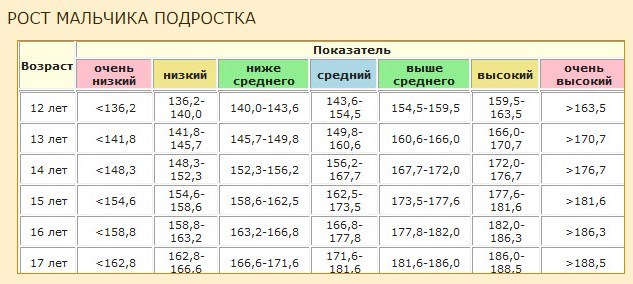
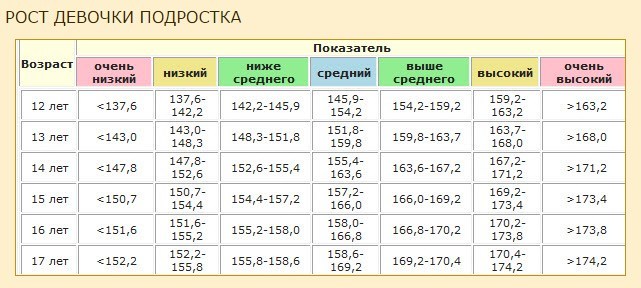
If your child's growth indicator is within the green or blue zone - his growth corresponds to the average growth, the yellow zone indicates that growth is normal, but there is a tendency to lag behind or ahead, this can be discussed at a pediatrician's appointment. If the growth rate is in the red zone, this may be a sign of a disease, do not delay the consultation of an endocrinologist.
Physical development and physique are 70% determined by heredity, and 30% by environmental factors.
The ratio of height and weight in adolescents: a table of height and weight

To assess the indicators of physical development, it is important to evaluate not only growth separately from other indicators, but also its relationship with weight.
The optimal ratio of height and weight in children and adolescents is represented by the following centile graphs. The method for evaluating indicators is similar to the method for evaluating centile tables described above: in the range from 3 to 97 centiles, we can talk about the norm, everything that is above or below these values requires the attention of parents and doctors.

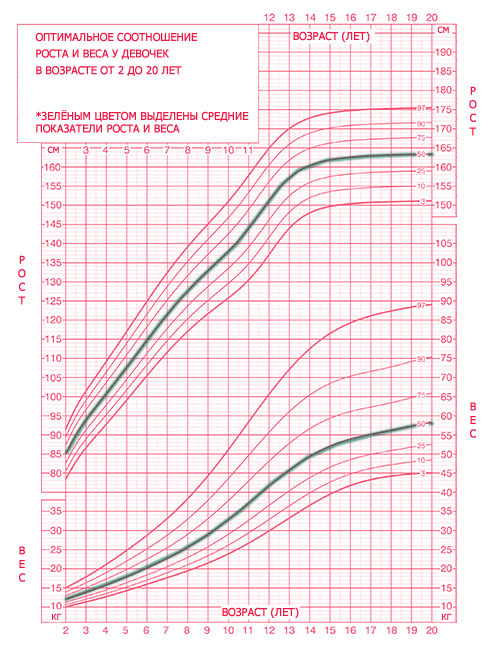
Periods of accelerated, intensive growth of a teenager

With the onset of puberty, there is a significant increase in the increase in the linear dimensions of the body and its mass - the so-called pubertal growth spurt occurs.
Girls growth spurt begins at an average of 10.5 years, the growth increases most significantly between 11 and 12 years - an increase in body length can reach 8-10 cm per year. By the age of 13-13.5, the rate of increase in growth decreases, changes in the ratio of body parts continue.
Boys the period of accelerated growth begins 1-2 years later, at 115-16 years of age, the growth rate reaches its maximum (an increase in growth can reach up to 8-9 cm per year), and slows down by 18-19.
Thus, girls "stretch out" earlier and at 11-14 years old surpass boys, both in height and in body weight.
The intensity of growth in the pubertal period can be both uniform and spasmodic. In the latter case, the entire annual increase can occur in a few months - more often in the summer-autumn period.
During accelerated growth, a significant change in the proportions of the body of a teenager is noted - awkwardness of the figure, lankyness, long and thin limbs. This can lead to temporary discoordination of movements. The teenager himself can negatively evaluate such features of the body, which in turn causes negative feelings about his appearance, self-doubt.
Without exception, all the physiological functions of a teenager undergo significant changes during the period of active growth. This can lead to an imbalance in individual body systems. In most adolescents, muscle tissue does not keep pace with the growth of the skeleton, so-called "growing pains" appear. The cardiovascular system also undergoes profound physiological changes, which causes sudden pressure surges.
Small stature of a teenager: how to increase?
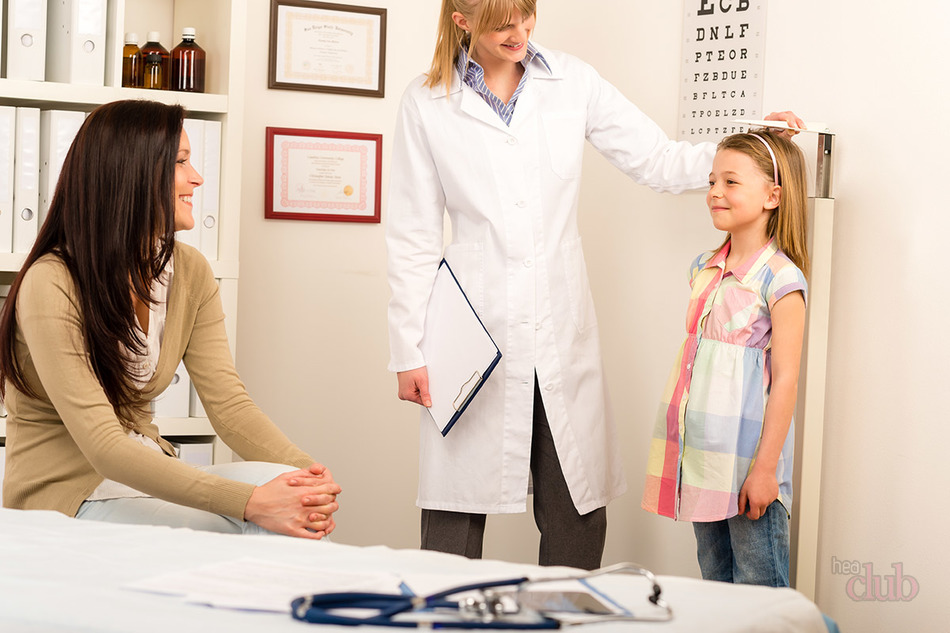
The low growth of a teenager can be genetically determined, that is, it can be a variant of the norm.
To distinguish genetic short stature from short stature caused by other causes, it is necessary to take into account the height of the adolescent's parents, analyze the growth curve and determine the bone age.
- Compiling a growth curve gives a more complete picture than comparing single measurements with average growth rates. If the child's growth curve in all age periods located below the optimal curve, and at the same time parallel to the lower boundary of the normal curve, then, most likely, we are talking about genetic stunting
- Information about the maturation of the bones is given by the radiograph of the growth zones. For this purpose, in children older than 2 years, an x-ray of the left hand and wrist is taken, according to which the doctor can determine the bone age. Normally, the condition of the bones should correspond to the age of the child.
Short stature, not associated with a genetic predisposition, can be caused by such reasons:
• malnutrition in general or deficiency of some of its components (vitamins, trace elements), indigestion and absorption in the intestine
• excessive exercise
• various chronic diseases
• chromosomal abnormalities
• hormonal disorders
A detailed medical examination will help to establish the cause of a teenager's low growth, first of all they pay attention to the state of the endocrine, cardiovascular systems, kidneys and liver. Treatment for short stature is determined by the doctor and depends on the identified cause of the disease.
High growth teenagers
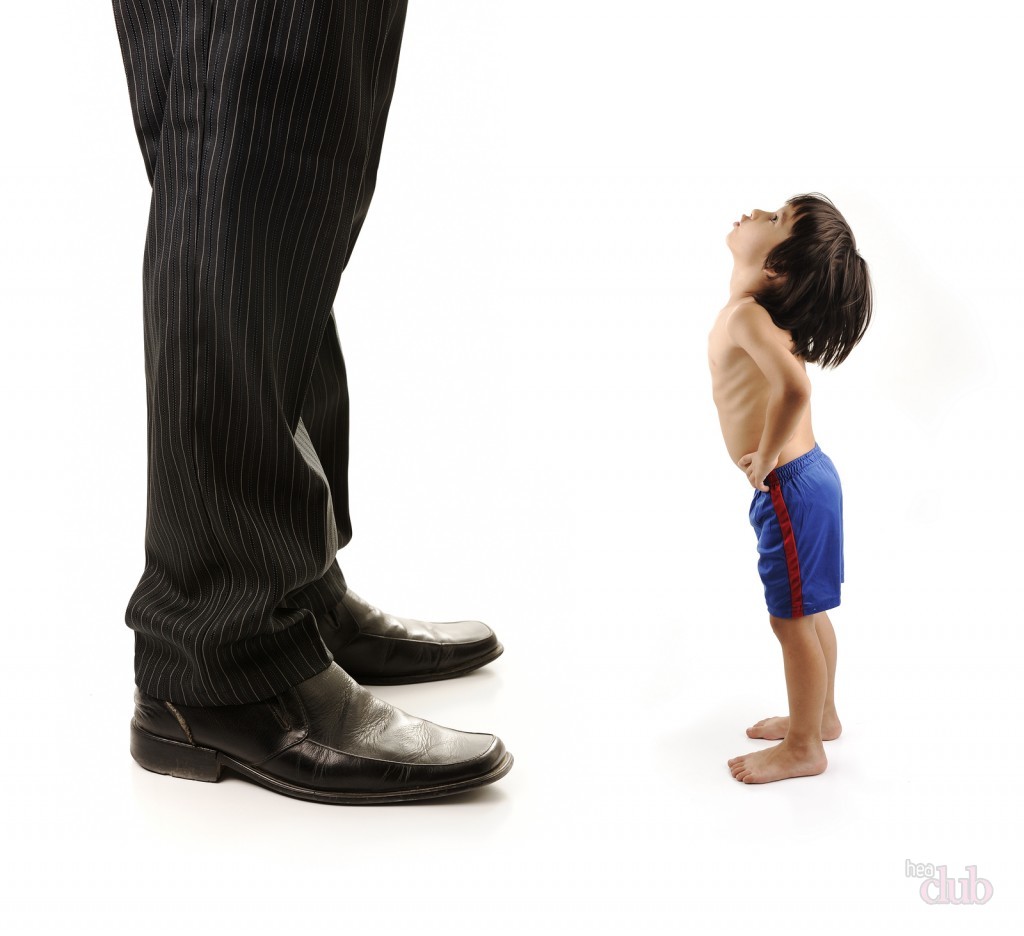
Tall stature is considered less of a problem for a teenager than short stature, and is sometimes rated as an advantage.
Constitutional-hereditary, or genetic tallness is caused by the high growth of parents or close relatives, is considered the norm and does not require any treatment. In this case, the teenager:
- growth rates correspond to normal indicators in all age periods (this can be seen when building a growth curve)
- bone age corresponds to chronological
- there are no pathological symptoms of the central nervous system or endocrine glands
If the high growth of a teenager is not associated with heredity, it is necessary to pay attention to his health, first of all, to the state of the endocrine organs. Another reason for the high growth of a teenager is chromosomal genetic abnormalities. In such cases, it is necessary to seek medical help for diagnosis and necessary treatment.

As we noted above, during a period of active growth, the importance of good nutrition is very high. For the work of enzymes that regulate biochemical processes in the body, vitamins are necessary. Each of the vitamins is "responsible" for its own "site" of metabolic processes, therefore, there are several dozen diseases caused by beriberi.
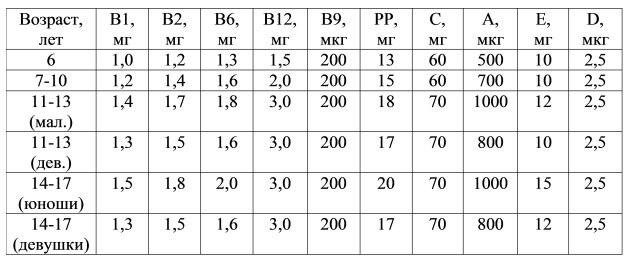
Teen Body Growth Exercises
Many teenagers and their parents are very worried about small stature and are ready to do anything to “grow up”, including such drastic measures as taking hormonal drugs or surgery.
Is there a way to accelerate the growth of a teenager's body without the risk of complications or side effects from taking various drugs - this is physical training.

Here are a few effective exercises for growth. They must be done regularly, preferably in the morning, in each position to linger for 3-6 breath cycles.
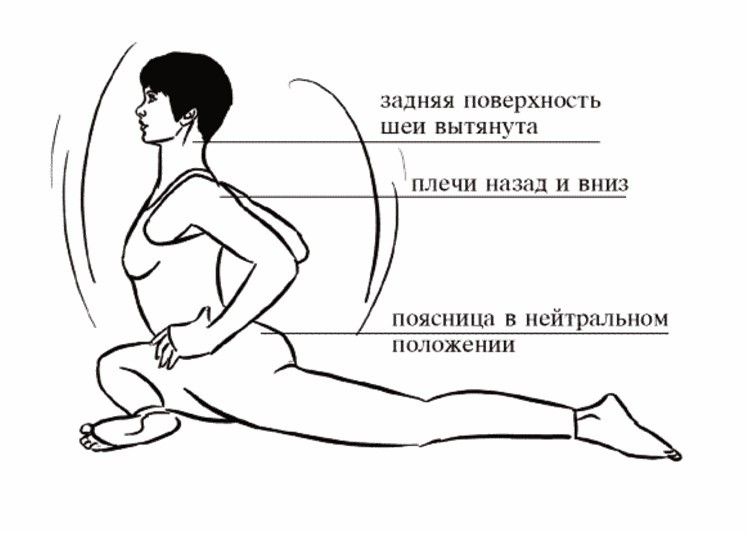

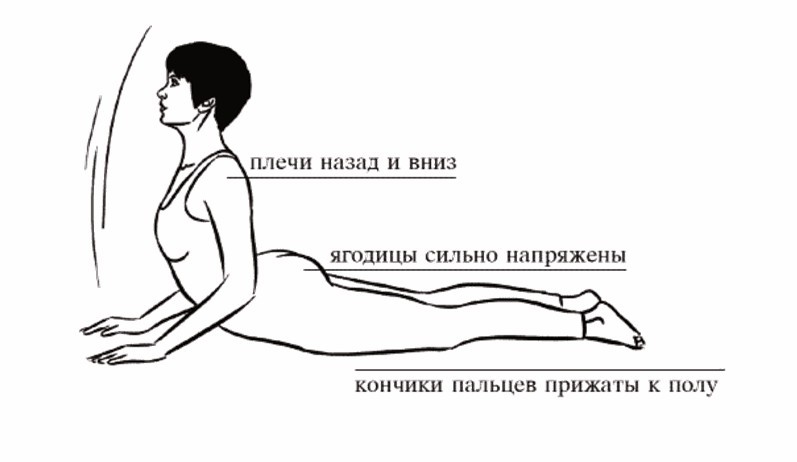
Adolescence is a time of dramatic physiological changes and the development of social status. IN Western cultures it is a transitional period between childhood and adulthood, usually spanning the period from 12 to 20 years of age. Most of the significant changes in adolescence occur in the first few years of this period (Lerner et al., 1991; Wheeler, 1991). However, important and profound changes in behavior and role relationships take place during this entire span of life. From the point of view of cross-cultural standards, adolescence in our society is somewhat stretched. In many cultures (and in the West in the pre-industrial era), the role of the adult was accepted in a much more early age. The child entered adulthood with the onset of puberty, and in a person's life there was no long period with the status of a child-adult.
puberty(Latin pubescere, to be covered with hair) is a term often used to refer to a period of rapid physiological change during early adolescence. The mechanisms that trigger a series of changes are not fully understood. However, it is known that the hypothalamus plays a key role (Brook, 1999a; Caufriez, 1997; Foster, 1992). If you speak in in general terms, at the age of 8 to 14 years, the secretion of substances increases in the hypothalamus, stimulating the production of more hormones by the pituitary gland into the blood, called gonadotropins(Brook, 1999a). These hormones are chemically identical in boys and girls. They stimulate the activity of the gonads. But in men, they cause an increase in testosterone production, and in women, they stimulate the ovaries to increase estrogen levels. In about 97% of boys and girls, the first signs of puberty are testicular (in boys) and breast (in girls) enlargement by age 14 (Brook, 1999b).
Puberty (puberty). A period of rapid physiological change during early adolescence during which the reproductive organs mature.
Gonadotropins. Pituitary hormones that stimulate the activity of the gonads (testicles and ovaries).
In response to an increase in the level of male and female hormones, the outward signs of maturation of a man and a woman begin to appear. The results of these changes (enlargement of the mammary glands, lowering of the voice, growth of facial, body and pubic hair) are called secondary sex characteristics. The growth of pubic hair in both sexes and swelling of the mammary glands (slight protrusion under the nipple) in girls are usually the most early signs puberty. This is followed by a dramatic acceleration of growth, stimulated by an increase in the levels of sex hormones, growth hormone, and another substance called insulin-like growth factor I (Caufriez, 1997). In the future, growth stops, again under the influence of sex hormones, at the signal of which the growth zones in the bones are closed. Girls have a growth spurt two years earlier than boys, making them taller than their peers in early adolescence (Brook, 1999a; Middleman & Emans, 1995). The external genitalia also increase - the penis and testicles in boys, the labia - in girls (Fig. 9.1).
Rice. 9.1. Hormonal changes during puberty, caused by the influence of the hypothalamus on the pituitary gland, as well as stimulation of rapid growth and the development of secondary sexual characteristics
Secondary sexual characteristics. Physical signs (other than the genitals) that indicate puberty are the appearance of body hair, the growth of the mammary glands, and a lowering of the voice.
The only clear difference between puberty in boys and girls is height (Brook, 1999a). Estrogen stimulates the secretion of growth hormone in the pituitary gland more than testosterone. Therefore, after reaching puberty, girls begin to grow faster (Brook, 1999a). Although the magnitude of the pubertal growth spurt is about the same for both sexes, it begins two years earlier in girls than in boys. This is why the average 12-year-old girl is significantly taller than her male peer. According to one of the authors, early growth acceleration and signs of mammary gland development are "the reason for the myth that puberty occurs earlier in girls than in boys" (Brook, 1999a, p. 53).
Under the influence of hormonal stimulation during puberty, both sexes experience further development internal organs. In girls, the walls of the vagina thicken, the size and muscles of the uterus increase. In response to the changed hormonal status, secretion into the vagina and cervix increases and the pH of the vagina changes from alkaline to acidic. Then menstruation begins. The first menstrual cycle is called menarche. Initially, monthly cycles may be irregular and occur without ovulation. For some girls, periods remain unstable for several years before becoming regular and predictable. Therefore, the method of birth control based on the monthly cycle is especially unreliable in women of this age. age group. Most girls start menstruating at 12-13 years of age, although the age of menarche varies greatly (Herman-Giddens et al., 1997; Wheeler, 1991). Research suggests that menarche is triggered at a certain minimum body fat reserve (Frisch & McArthur, 1974). At the beginning of puberty, the average ratio of lean tissue to fat in girls is 5/1 (that is, fat is about 1/6 total weight body), and at the time of menarche, it approaches 3/1 (that is, about a quarter of body weight is fat). There is more evidence for a link between body fat and menarche. They come from observing female athletes and ballerinas with long and demanding training schedules. These adolescents often experience delayed menarche or intermittent periods (Epp, 1997; Warren, 1982). Presumably this is due to an insufficient amount of fat in the body.
A recent survey of 17,077 girls aged 3 to 12 years (USA) showed that girls reach puberty earlier than indicated in classic pediatric textbooks (Herman-Giddens et al., 1997). In this observation, secondary sexual characteristics began to develop by the age of 8 among whites (constituting 90% of the sample) - in about 15% of girls and among African Americans (10% of the studied population) - in half. The authors of this study put forward their hypothesis. They suggest that environmental estrogens, substances similar to human estrogens, may be the cause of this early puberty. The main sources of estrogens in the environment include certain types of plastics and insecticides, which "decompose into molecules that have an estrogen-like physiological effect on living organisms" (p. 511).
The authors of this important work suggests that it may be necessary to reconsider the timing of sexuality education in schools. Marcia Herman-Giddens, lead author of the study, recently said: "I don't think parents, teachers, or society today take seriously the fact that puberty begins as early as second or third grade" (Coleman, 1997, p. A9 ).
In boys at puberty, the prostate gland and seminal vesicles increase significantly. Although boys can experience orgasm during childhood, ejaculation is not possible until the prostate and seminal vesicles begin to function under the influence of increased testosterone levels. Typically, the first ejaculation occurs one year after the onset of growth acceleration (usually around 13 years of age), but, as with menstruation, this varies greatly (Stein & Reiser, 1994). The first spermatozoa appear in the ejaculate by the age of 14 (Kulin et al., 1989; Wheeler, 1991). Kinsey (1948) wrote that in about two-thirds of boys, the first ejaculation occurs during masturbation. After the first menstruation or ejaculation, most girls and boys experience a period of early adolescence infertility. However, it cannot be relied upon as a method of birth control. In some boys, sperm production begins early in puberty, and even the first ejaculate may contain live sperm (Abrahams, 1982).
The change in voice caused by the growth of the larynx is noted in both sexes, but it occurs most dramatically in boys. The latter often feel awkward when their voice breaks and jumps from low to high tones and vice versa. Facial hair in boys and axillary hair in both sexes appear about two years after pubic hair. Increased activity of the sebaceous glands can lead to the appearance of pimples or blackheads on the face.
Many of these bodily changes can make a teenager and his/her family or friends feel anxious or proud. Embarrassment becomes a common reaction, and those who are ahead of or behind others in development are especially embarrassed:
"My chest hair was the earliest. I plucked it first because I didn't want to be different in the shower." (From the author's archives)
"All my girlfriends have been on their period for a long time, but I still haven't. I started using a pad once a month to not be so different from others." (From the author's archives)
The changes we have described occur quite quickly and intensively. The body to which long years a person is accustomed to, undergoes mysterious changes that are often embarrassing and upsetting:
"I would never want to go back to my early teens. My body was so unpredictable. At the most inopportune moments, my voice broke, my penis got erect, or acne popped up on my face. Sometimes it all happened at the same time!" (From the author's archives)
Social changes are also taking place. Changes in the friendship of a boy and a girl are not uncommon. Adolescents tend to become (at least temporarily) more homosocial, interacting in social environments mostly with members of their own sex. But this phase does not last long. Adolescence is characterized not only by physical changes, but also by important behavioral changes. In the following pages, we will focus on some of the important aspects of adolescent sexual behavior.
